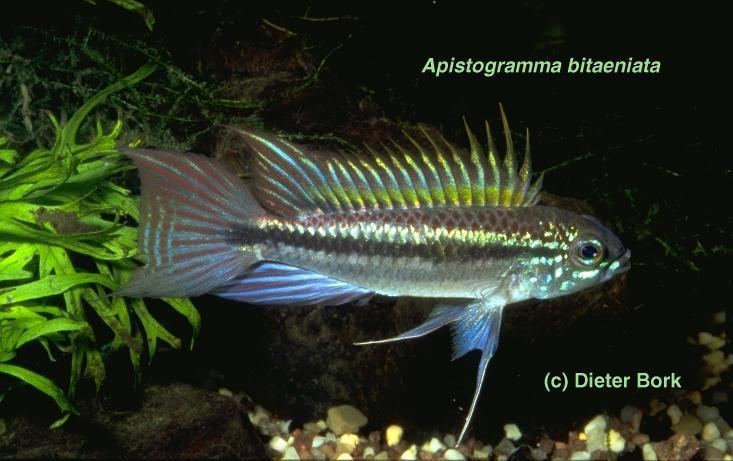Order Perciformes Higher classification Apistogramma | Phylum Chordata Scientific name Apistogramma bitaeniata Rank Species | |
 | ||
Similar Apistogramma, Cichlid, Apistogramma agassizii, Apistogramma macmasteri, Apistogramma elizabethae | ||
Banded dwarf cichlid (Apistogramma bitaeniata) is a species of benthopelagic freshwater fish from South America. It is a popular dwarf cichlid among fishkeepers.
Contents
It is found in blackwater rivers of the Amazon Basin in Brazil and Peru.
Biotope
Leaf littered black, clear-water, white-water, shallow slow moving water of its home range.
General body form
Small fusiform body with large eyes and mouth. Irregular lateral line. Generally, fins are long and stiffly erected by rays. Dorsal fin: spiny rays anteriorly, soft rays posteriorly and serrated. Pelvic fins are long, veil-like and possess spiny rays. Caudal fin is strong and lyre-shaped. Sexually dimorphic.
Aquarium diet
Enjoys a variety of live or frozen artemia, bloodworm, black worms, brine shrimp, marine crustaceans, mosquito larvae and tubifex as well as pelleted foods containing fish and spirulina. Foods containing chitin and cellulose (as found in invertebrates and spinach prevent constipation and help ensure nutrients are absorbed. Feed small portions 2 – 3 times per day.
Coloration
Males: There are many color varieties available including blue, orange, red and yellow. In the blue morph, the body is blue-violet. The dorsal and anal fins are bright yellow-green, basally, and iridescent blue distally. The caudal fin has a center of iridescent blue and it flanked by yellow-green laterally. The pectoral fins are iridescent blue and just tipped with yellow-green. A thin, black bar strikes through the eye and extends across the gill cover. A bold black stripe extends from almost the tip of the nose, through the eye and traces the lateral line just past the caudal peduncle. A second line is variable and may appear just below this line. Sexually dichroic.
Sexing
Males tend to be larger than the females. Males will grow to 3.5 inches, females will reach 2.5 inches. Adult males will also have a lyre shaped caudal fin.
Lifespan
The expected life span for banded dwarf cichlids is 5–6 years.
Aquarium breeding
OVIPAROUS. Cave-spawner. Sexual Dimorphism: both dimorphic and dichronic-- females are smaller, have smaller fins and are less brightly colored. Prior to breeding, condition fish with heavy feedings of quality food, especially live foods. A large water change may stimulate spawning. As these fish are polygamous, a male may spawn with multiple females at the same time. Females lay approximately 100 eggs on the ceiling of caves, under rocks or in crevices like those found in driftwood while the male defends the territory. Eggs and fry are tended to by the female parent. In five to six days when they are hatched, fry are free-swimming. They can be fed nauplii and Anguillula aceti once the yolk sac has been absorbed. If the male shows increased aggression toward the female, he should be removed to a separate tank. The sex of the fry is influenced by water conditions, with softer, warmer water producing more males. While spawning is possible in a community tank, a breeding tank is recommended.
Diseases
Not overly susceptible to any of the more common diseases and parasites.
